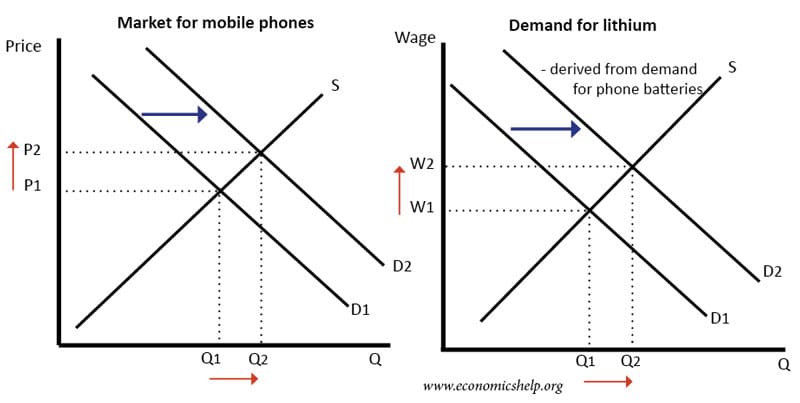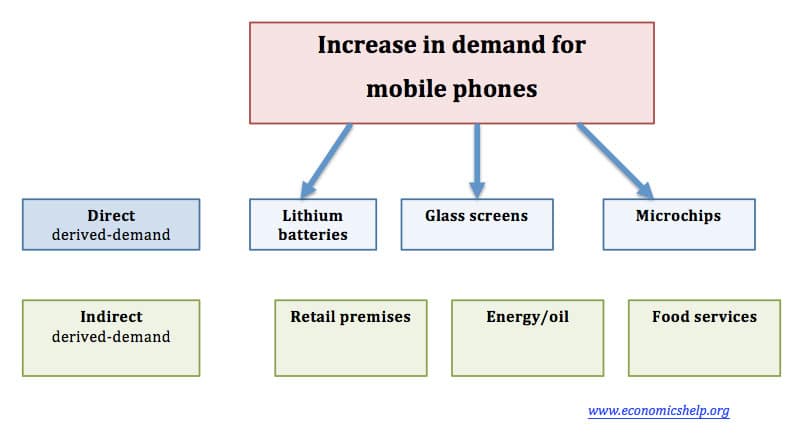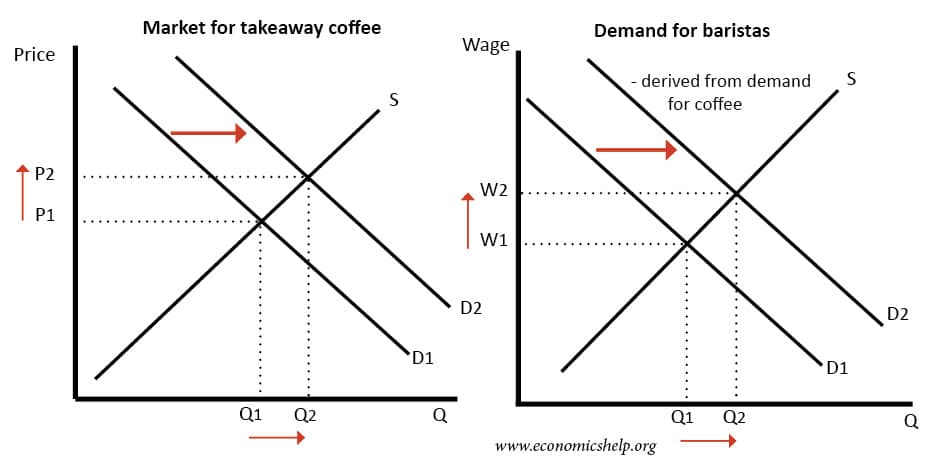Derived demand occurs when there is a demand for a good or factor of production resulting from demand for an intermediate good or service.
Example – mobile phones and lithium batteries
The rise in demand for mobile phones and other mobile devices has led to a strong rise in demand for lithium. Lithium is used in the batteries.

Derived demand – direct and indirect
The increase in demand for mobile phones will also cause derived demand for other components such as glass screens and micro-chips.
Indirectly, a rise in demand for mobile phones may cause a rise in demand for retail premises (to sell them). There will also be derived demand for energy/transport and even food services in the location where phones are produced sold.
Example of Labour as Derived Demand
In this case, greater demand for buying coffee leads to greater demand for baristas (coffee-makers)
The demand for economic tutors depends on the demand for students wishing to study economics. If students sign up for an economics course, then the college will demand tutors to be able to teach the students.
The demand for coal workers is highly dependent upon the demand for coal. As the demand for British coal fell in the 1980s, demand for coal miners declined.
Marginal Revenue Product Theory
Marginal Revenue Product Theory states that demand for labour depends upon the productivity of a worker and the marginal revenue of the goods sold. MRP = MPP * MR
- MPP = Marginal physical product
- MR = Marginal Revenue of goods sold
If demand for the good increase, the price and MR will increase leading to higher demand.
Transport as Derived Demand
Demand for transport tends to be determined by the demand for another service/activity. If people need to get to work, they will demand more bus journeys. Few people take a bus for the intrinsic pleasure of a bus journey.
Demand for car travel in the UK is closely related to economic growth. WIth more economic activity, there is greater demand for travelling by car.
Similar concept – Joint Demand / Complementary Demand
This occurs when two goods are needed together. For example,
- Mp4 downloads and an iPod player.
- A tennis ball and a tennis racket.
Related



thank you so much for this information it has really helped me understand derived demand to a simpler understand.
Is demand for cement derived demand?
Yes. Demand for cement will depend on demand for housing and construction.
What is the difference between Derived Demand and Joint Demand?
Its so helpful,,,,, how can I cite this article??
Install citeforme in the chrome extension, and using that, you can easily create a citation of this article or any article on the web.
I don’t still really understand this derived demand, someone should please help me breakfast it down to a smaller way please
I understand that we can classify demand (from this point of view) in 3 classes:
1. Independent demand – it cannot be calculated as it depends on independent decisions by individuals, groups or companies. It can only be estimated, forecasted. Examples: consumers’ demand for beer, demand for cruise tours to Jamaica.
2. Dependent demand – it is mathematically dependent upon the production of another item. If a plant will produce 100 units of a cell phone and each cell phone requires 4 screws, the demand for the screws can be mathematically calculated to be 400. If you will make 4 recipes of a cake and each requires 3 eggs, you will have a demand for 12 eggs. The demand for screws and eggs is dependent upon the production schedule of cell phones and cakes. Dependent demands must not be forecasted, as forecasting always implies error. They should be calculated. A similar application of dependent demand can occur in a distribution network. If a Distribution Center should service 4 distributors and if those distributors are able to forecast their respective demands and plan for their demands on the Distribution Center, it is unnecessary for the DC to forecast the demand. It can simply rely on the distributors’ plans and calculate the sum of their planned demands. You can say that the demand on the DC is dependent upon the demands and inventory management of the distributors.
3. Derived demand – I use it when there isn’t a fully reliable “mathematical” dependence of one demand upon another, but there is some important correlation or causal effect.
If you issue a license to start a construction, it should cause a demand for construction materials in the following months. One cannot set a fixed mathematical dependence because the construction owners may choose different materials and the quantities will vary based on size, height, etc.. While you don’t have a fixed mathematical relationship as in the case of manufacturing a product that requires fixed amounts of components, you can derive some statistical relationship that will greatly help you forecast the derived demands. For example, in a certain region, every 100 construction licenses issued typically generate the demand for 200,000 square feet of roof material. Typically means that it can vary, it is not a fixed mathematical relationship. It can be statistically reliable to support a forecast but it is not precise enough to be considered a dependent demand.
Hope it helps
thank u so much for the informantion it has really helped me with my research…….
I think derived demand is demand for goods and services not for it’s on sake but for it’s purpose for example demand for lithium used in phone batteries.
I think I can put it in this way sir,When the needs of certain object needs or require another to make it work effectively for instance if kerosine is derived or brought because of kerosine stove, petrol or car tire is need to aid the movement of a car
Can you answer this Question?
– Explain why the demand of transport by manufacturing and constriction industries is a derived demand.